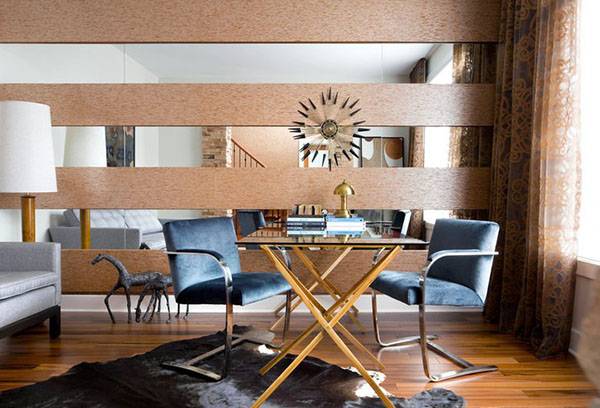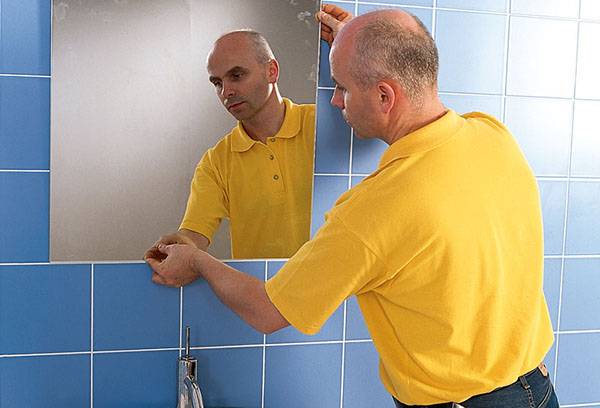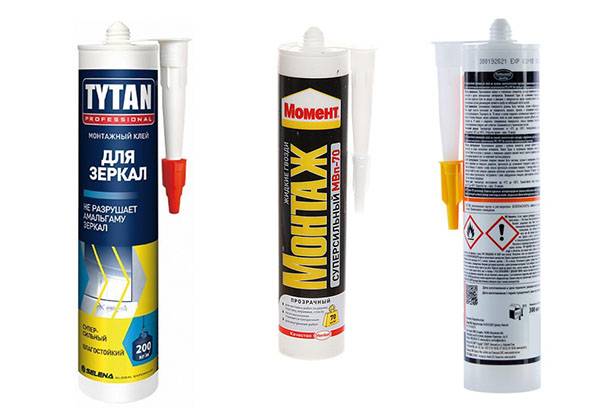How to use mirror glue correctly?
When decorating interiors, you often need mirror glue to secure glass to surfaces made of various materials. If you purchased a finished product in a frame, it can be secured to the wall using regular nails or special fasteners. The imagination of the owners often goes beyond banal solutions and prompts them with the most unusual ideas. Reflective elements can be scattered among the tile cladding, decorate doors, partitions, and furniture. If you have a small narrow room or a hallway that resembles a dungeon, install a mirrored wall - the room will immediately look more spacious and brighter.

Requirements for glue for mirrors in dry rooms and in the bathroom
It is important not only to decide how to glue the mirror to the wall, but also to choose the right material for the job. The increase and decrease in glass dimensions due to temperature changes may not coincide with changes in the dimensions of the material on which the mirror is glued. If the composition forms a solid substance after drying, tension will arise in the decorative elements and they may fall off the base or crack. If the connecting layer turns out to be elastic, but adheres well to both the glass and the base material, everything will hold securely and last a long time.
When attaching mirrors and other decorative elements, not only the strength and reliability of the connection is important. Living rooms where people are constantly present and children play are often used to decorate living rooms with mirror elements.If over time or under the influence of temperature the glue begins to release toxic compounds, the health of all family members will suffer. When purchasing, be sure to check the instructions to see if this composition can be used in residential areas.
There are other requirements for mirror glue:
- ease of use - glue for mirrors should be easily applied to surfaces and form a thin, uniform film;
- the composition should not contain acids or alkalis;
- the drug should not destroy not only glass, but also amalgam;
- it is desirable that the composition sets quickly, otherwise you will have to hold the mirror with your hands for a long time or install complex fastening structures;
- The glue should not change color when drying, so that there are no noticeable stains along the edges of the structure.
Some owners like to decorate bathrooms and shower rooms, and sometimes even baths, with mirrors. In this case, the composition must withstand high humidity and temperature well. An unreliable connection will not only lead to the need to redo the work - due to poor glue, injuries can also occur. Falling glass will break into many pieces, and it will be very difficult to sweep them all away. Someone could step on a sharp piece with a bare foot and injure their foot.
What types of glue are used to install mirrors?
The chemical industry produces many different types of glue. Any finishing material can be attached to a building structure without dowels, screws or other metal fittings; adhesives create a strong and reliable seam.
All compositions used to secure mirrors can be divided into 3 groups, each of which has advantages and disadvantages:
- solvent-based products;
- silicone compounds;
- hybrid options.
Solvent glue is the cheapest material. When choosing a brand, look at what is written in the instructions: the composition is approved specifically for mirrors or just for glass. Sometimes components are added to the drug that can destroy the amalgam. At first, such a defect is not always noticeable, but over time, stains appear and the decorative element loses its attractive appearance.
Silicone compounds are chemically neutral and do not cause unwanted reactions when in contact with other materials. The film provides good adhesion between the mirror and the base and does not peel off. When working, remember that the drying time for silicone compounds is longer than for solvents. Such materials are more expensive, but the quality and appearance of the finished structure are ultimately better.
It is easiest to work with hybrid formulations. If you do not have experience in repair work, give preference to this option. The adhesive does not contain solvents; it can be used for fastening various structures and for cementing. This material is expensive, but the connection is very high quality.
How to glue mirrors to the wall?
When creating an interior, it is not always possible to hang a mirror in a beautiful frame on the wall - sometimes it is required that the reflective surface be organically included in the decoration, appearing as a fragment of a single structure. The easiest option is to use double-sided tape. Press one side of the adhesive tape firmly onto the amalgam. Level the base, let the mortar or putty dry and press the glass tightly against the wall. This method is suitable for installing small light fragments, but a huge heavy structure will come off under the influence of its own weight.
Most often, adhesive tape is used as an auxiliary material. It is glued onto the amalgam, then the second protective layer is removed and glue dots are applied to the tape with a gun. When you press the mirror against the wall, the duct tape will help hold the glass in position until the base compound sets.
Before installation, carefully level the base. Read the instructions and learn how to use the glue correctly. When working with each brand there are subtleties. They are not always written about in the annotations; the masters mastered many of the tricks on their own. For example, when working with Moment Installation glue, it is recommended that immediately after applying the composition, press the mirror against the wall, immediately tear it off, and after 3-4 minutes install it completely. Do not hesitate to consult with an experienced specialist and ask how to glue a mirror to a wall - he will reveal many professional secrets to you.
Advice
When installing heavy mirrors, use Moment Super Tape material for fixation. Several strips will securely hold the massive glass, and after a day the fastening tape can be removed.
How to fix a mirror in a closet door?
Mirrors are often used to decorate furniture. You can install them on the side surfaces and finish the inside of the cabinet cavity. If you are starting to work for the first time, it is better not to start working on a complex connection right away. For practice, try installing a small glass on the lid of a medicine cabinet or a drawer with shampoos and gels in the bathroom.
Before sticking on the mirror, remove the cabinet door from its hinges and place it in a horizontal position. Mark the installation location, and then apply several strips of double-sided tape to the door.Apply strips of silicone-based adhesive between the adhesive tape.
Remove the protective layer from the tape and press the mirror firmly against the surface of the door. Make sure the glass is locked in the desired position. If the mirror is small, thin and light, you can hang the door in place after a few minutes. It is better to leave a heavy structure in a horizontal position for a day so that the composition can set well.
What composition will glue the mirror to the mirror or other materials?
The easiest way to solve the problem is if you want to glue a mirror to a mirror. Take any glue whose instructions indicate that it can be used for attaching mirrors. If the composition created good adhesion to one surface and did not destroy the amalgam, then the same thing will happen to the other glass. Use the material according to the instructions, and the connection will be strong and reliable.
If you need to stick a mirror on plastic, concrete or other material, make sure that the composition is suitable for both the reflective surface and the base.
The following brands have gained great popularity:
- "Titanium";
- Abro;
- "Moment Montage";
- Ottoseal silicone compound;
- Schenk.
Abro mirror adhesive is based on epoxy resin. It sets in 5 minutes and glues different materials well. When the composition dries completely, it remains transparent and does not leave unsightly marks or yellowish streaks. This compound can be used in children's and medical institutions; it will not suffer from frequent exposure to disinfectant solutions. You can glue mirror fragments in the bathroom and shower; humidity will not have a negative effect on the seams.
"Titanium" is made on the basis of resins and rubber.After drying, the connecting film remains elastic - the glass does not deform or crack due to temperature changes. This adhesive can also be used in showers and other wet areas.
The sparkling mirrors give the interior a mysterious, magical look. You can cover the entire wall with mirror sheets, and the room will seem twice as spacious. Small inserts and fragments will create an interesting play of light and add brightness to the interior. Using glue, you can attach reflective glass to any surface: plastic, wood, concrete, metal. Use the most durable and perfect compositions, find the most suitable glue for mirrors - and create a unique individual design for your apartment!

